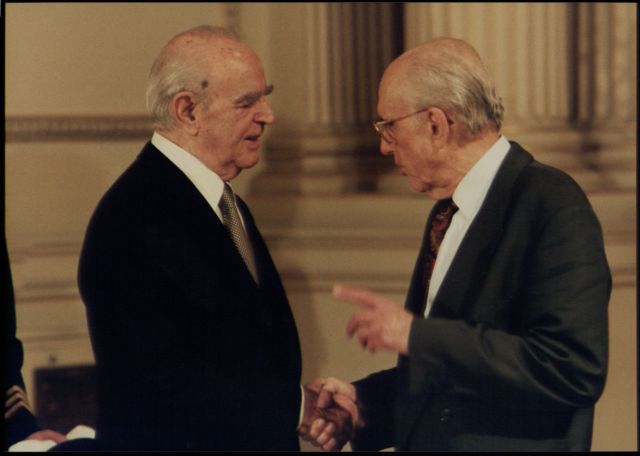The electoral spread between the two top parties is near record level, especially If the opinion polls – which are reminiscent of older elections when two-party predominance was so great that the country was divided into blue (ND) and green (Pasok) cafes – are confirmed.
Back in 1974, New Democracy won the general election by a 20 percentage point spread over Pasok.
At the time, the image was still fresh of Constantine Karamanlis, who would become ND leader, debarking in Athens from an aeroplane just hours after the fall of the junta in 1974.
The main slogan of the November, 1974 elections was “Karamanlis or tanks”.
In the elections of 1977 and 1981, the electoral spread between the two top parties was nearly 15 percentage points.
In 1981, the call of Pasok for Allagi (change) gave Pasok a 48 percent majority.
In the ensuing critical years, which were marked by political scandals and epic battles in Parliament between New Democracy and Pasok, the spread between the two top parties was below 10 percentage points.
By 2009, with the economic crisis already baring its teeth and with polarisation having returned to Greek politics, scared citizens seeking a way out handed Pasok a victory with an advantage of 10.45 percentage points over New Democracy.
After the tumultuous year 2012, following the governments of Lucas Papademos and Antonis Samaras, there was a large spread between ND and SYRIZA in the 2015 general election.
Polarisation was at limit high and the electorate was torn between pro- bailout memorandum and anti-memorandum parties. There was fear about the next day and disgust for all that had occurred in 2010.
The safe conclusion is that in difficult conditions two-party hegemony is bolstered and citizens adopt a stark white-black perspective – even if they realise that the complexity of problems and conditions do not permit such an approach.
Voters rally behind the two main political parties, annihilating smaller political parties.
Indicative of the social and economic conditions in which these elections are being conducted is the fact that a Public Issue poll gave New Democracy a 15 percentage poll lead over SYRIZA.
The spread between the two top parties in the last 40 years reflects the political mileu at any given point.
Between 1974 and September, 2015, we have interesting findings.
20.5 percentage point lead in 1974
The slogan in the 1974 election was “Karamanlis or tanks” and New Democracy garnered 54.37 percent of the vote, with 220 seats in the 300-seat legislature.
The Center Union received 20.42 percent of the vote with 60 seats.
The surprise was Andreas Papandreou’s newfangled Pasok party with 13.58 percent of the vote and 12 seats.
16.5 percent spread in 1977
Three years later New Democracy had another impressive victory but not as great as in 1974.
Constantine Karamanlis’ New Democracy received 41.84 percent of the vote and Andreas Papandreou’s Pasok garnered 25.34 percent.
Georgios Mavros Center Union was history and Pasok became the main contender against ND, forging the new post-junta two-party system.
The fledgling “Neo-Liberal” party of Konstantinos Mitsotakis (father of Kyriakos Mitsotakis) garnered just 1.08 percent of the vote.
Pasok’s 12.19 lead over ND in 1981
1981 will remain in history as the year of Change – Pasok’s mantra – and Pasok garnered 48.07 percent of the vote (a 22.73 percent gain).
New Democracy under Georgios Rallis received 35.88 percent.
Pasok won 172 seats in the 300-seat legislature and New Democracy only 115 seats.
Lead of only 4.97 percent in 1985
Andreas Papandreou again won the 1985 election but with a margin of less than five percentage points. Pasok garnered 45.82 percent of the vote (161 seats) and Konstantinos Mitsotakis’ New Democracy garnered 40.85 percent (126 seats).
ND rebounds with a 5.8% lead in June, 1989, and 5.52% in November, 1989
The huge Yorgos Koskotas scandal tips the political balances. Mitsotakis’ ND places first aftrer 12 years with 44.28% of the vote, compared to Pasok’s 39.13 percent.
ND proves unable to form a single-party government and thus forms a coalition with Tzanis Tzanetakis as PM, allowing the prosecution of those implicated in the Koskotas scandal.
General elections were held 5 months later and the only loser was left-wing Synaspismos.
ND with 46.19 percent and 148 seats had gains as did Pasok with 40.67 percent and 128 seats.
Hence, ND, Pasok, and Synaspisos were forced to form a coalition government under Xenophon Zolotas.
ND beats Pasok by 8.28 percentage points in 1990
The third election in one year gave Mitsotakis’ ND 46.89 of the vote (150 seats) and Papandreou’s Pasok garnered 38.61 percent.
ND was unable to form a single-party government. Kostas Katsikis, an MP of Kostis Stephanopoulos’ DIANA party, gave ND the crucial vote needed to govern.
Pasok returns in 1993 with a 7.58 percentage point lead over ND
The political “cleansing” was completed but Mitsotakis’ liberal programme was met with stiff resistance from society.
Yet, the undoing of the Mitsotakis government was the Macedonian naming issue and the departure of Antonis Samaras.
Samaras created the splinter “Political Spring” party and called on other ND MPs to join him.
That is exactly what ND MP Yorgos Simbilidis did, toppling the ND government of Mitsotakis.
1993 rebound of Pasok
Pasok won the next election with 46.88 percent of the vote versus ND’s 39.3 percent and secured single-party rule.
Pasok wins with 3.37 percent margin in 1996
In his first electoral contest as Pasok president Costas Simitis won with 41.49 percent of the votes (162 seats), versus 38.12 percent and 108 seats for ND leader Miltiadis Evert.
Pasok wins by only a 1.05 percent margin in 2000
The 2000 general election is notable for the fact that it had the only photo finish result since 1974 and that there was a last-minute upset.
“Greece went to bed with Kostas Karamanlis as PM and woke up with Kostas Simitis as PM,” the press wrote at the time.
Simitis won with a lead of only 73,000 votes with 41.49 percent of the vote (158 seats) versus 38.12 percent for ND (125 seats).
ND wins by a 4.81 percent margin in 2004
In his first general election as ND leader Kostas Karamanlis with 45.36 percent of the vote (165 seats) beat Pasok leader Yorgos Papandreou, who garnered 40.55 percent of the vote (117 seats).
Karamanlis re-elected by 3.74 percent margin in 2007
In his second general election contest with George Papandreou, Karamanlis won by a smaller margin (3.74 percent). ND lost 3.5 percentage points and garnered 41.84 percent.
Pasok lost 2.5 percentage points and garnered 38.1 percent.
Papandreou takes 2009 election with 10.45% margin
The global economic crisis that had begun a year earlier in the US had already begun to impact on Greece.
George Papandreou’s Pasok garnered 43.92 percent of the vote compared to New Democracy’s 33.47 percent of the vote.
The end of two-party hegemony
In the 2012 general election, New Democracy placed first but with only 18.85 percent of the vote. It lost 15 percent of its electoral base since the previous election.
Pasok with Evangelos Venizelos as leader lost a whopping 30 percent of its base since the previous election and garnered only 13.18 percent of the vote.
Pasok finished as third party for the first time since 1974.
Alexis Tsipras’ SYRIZA finished second with 16.78 percent of the vote.
It had garnered only 4.6 percent of the vote in the 2009 general election.
Only 2.77 spread in May, 2012 general election
It was not possible to form a government after the May, 2012 general election and a second election was heard a month later.
That general election established New Democracy and SYRIZA as the two main poles of the Greek political system.
New Democracy garnered 29.66 percent of the vote (129 seats) and SYRIZA received 26.89 percent (71 seats).
A coalition government was formed with members of New Democracy, Pasok, and the small Democratic Left (DIMAR) party.
SYRIZA wins January, 2015 election with 8.53 percentage point spread
The European Parliament election of 2014 paved the way for SYRIZA rule.
The coalition government comprised of ND-Pasok-DIMAR shut down ERT state television and DIMAR left the government for that reason.
ND leader Antonis Samaras expedited the election of the President of the Republic in Parliament but he lacked the requisite majority.
SYRIZA comes to power in January, 2015
In the January, 2015 election SYRIZA came to power with 36.43 percent of the vote (148 seats) versus 27.8 percent of the vote (76 seats) for Antonis Samaras’ New Democracy.
Second SYRIZA victory in September, 2015
In July, 2015, PM Alexis Tsipras called a referendum on the third bailout programme, which he called on the public to vote down.
A whopping 62 percent of voters voted down the agreement and Samaras resigned his post as ND president.
Just a few days later Tsipras signed the third bailout memorandum and tabled it in Parliament for ratification.
Tsipras lost 40 MPs from his parliamentary group and held a second general election to secure a parliamentary majority.
SYRIZA received 35.46 percent of the vote compared to 28.1 percent of the vote for New Democracy.





